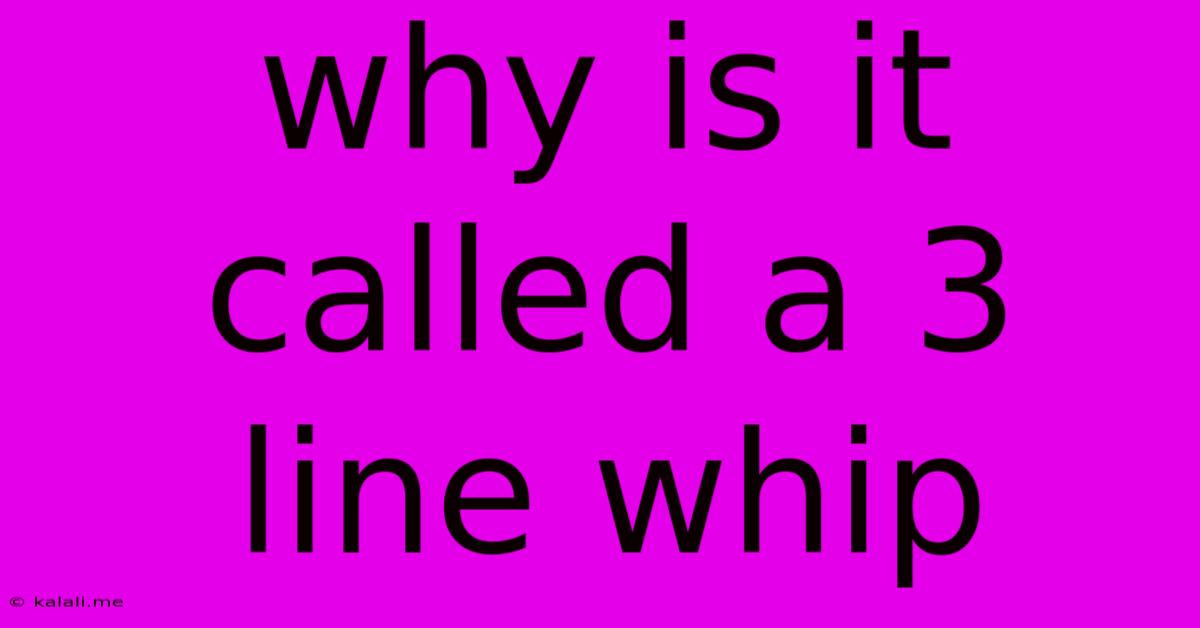Why Is It Called A 3 Line Whip
Kalali
May 19, 2025 · 3 min read

Table of Contents
Why Is It Called a 3-Line Whip? Understanding the Origins of Parliamentary Pressure
The term "three-line whip" evokes images of intense political pressure and unwavering party loyalty. But where did this dramatic phrase originate, and what does it actually mean? This article delves into the history and significance of the three-line whip, exploring its origins and its role in modern parliamentary systems, particularly within the UK context.
What is a Whip? Before understanding the three-line whip, we need to grasp the concept of a parliamentary whip itself. Whips are members of a political party in a legislature responsible for ensuring that their fellow party members vote according to the party line on important issues. They act as a liaison between the party leadership and individual MPs (Members of Parliament) or Congressmen, influencing voting behaviour and maintaining party discipline.
The Three-Line Whip: A Hierarchy of Pressure The "lines" in a three-line whip refer to the visual representation of the instruction. Historically, whips were communicated through written notes, with the urgency conveyed through the number of lines:
- One-line whip: A suggestion or recommendation. Attendance is encouraged, but non-attendance is not a significant issue.
- Two-line whip: A strong recommendation to attend and vote according to the party line. Non-compliance may result in minor consequences.
- Three-line whip: This is the most serious instruction. Attendance and voting with the party are mandatory. Failure to comply can result in significant consequences, potentially including expulsion from the party.
The three-line whip represents the highest level of pressure a party can exert on its members. It signifies an issue of paramount importance to the party's agenda and cohesion.
Why Three Lines? The Mystery of the Origin While the function of the three-line whip is well-understood, the exact origin of the three-line format remains somewhat shrouded in mystery. There's no definitive historical record pinning down the precise moment this system was adopted. However, several theories exist:
- Visual Emphasis: The simple and clear visual distinction between one, two, and three lines provided a straightforward way to communicate the level of urgency and expectation. This clear visual cue minimized ambiguity and ensured everyone understood the weight of the instruction.
- Evolutionary Development: The system likely evolved gradually. Initially, simpler forms of communication were used, with the number of lines increasing as the need for stronger enforcement arose.
- Historical Precedents: Some scholars suggest that the system may have been influenced by similar practices used in other organizations or institutions prior to its adoption in parliamentary settings.
Consequences of Ignoring a Three-Line Whip: The consequences of ignoring a three-line whip can be severe, depending on the specific party and the issue at hand. Potential repercussions can include:
- Loss of committee positions: Members who consistently defy the whip may lose influential positions within the party structure.
- Exclusion from candidate selection: They may be less likely to be selected as candidates for future elections.
- Expulsion from the party: In extreme cases, defiance can lead to expulsion, forcing the MP to sit as an independent member, significantly impacting their political career.
The Three-Line Whip in Modern Politics: The three-line whip remains a powerful tool in maintaining party discipline and ensuring the smooth passage of crucial legislation. While the method of communication may have modernized (emails and text messages are now more common than handwritten notes), the underlying principle of hierarchical pressure remains unchanged. It continues to be a key element in the dynamics of parliamentary politics, highlighting the tension between individual conscience and party loyalty. Understanding the significance of the three-line whip is crucial to comprehending the inner workings of many modern parliamentary systems.
Latest Posts
Latest Posts
-
Fourier Transform Of A Gaussian Function
May 19, 2025
-
Why Does Melting Point Decrease Down Group 1
May 19, 2025
-
Do Torches Stop Mobs From Spawning In The Nether
May 19, 2025
-
Do Capital Letters In Email Addresses Matter
May 19, 2025
-
I Would Appreciate If You Could
May 19, 2025
Related Post
Thank you for visiting our website which covers about Why Is It Called A 3 Line Whip . We hope the information provided has been useful to you. Feel free to contact us if you have any questions or need further assistance. See you next time and don't miss to bookmark.